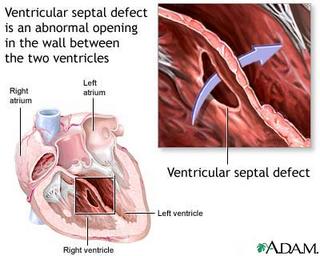
Definition:
Ventricular septal defect describes one or more holes in the muscular wall that separates the right and left ventricles of the heart -- the most common congenital (present from birth) heart defect.
Ventricular septal defect describes one or more holes in the muscular wall that separates the right and left ventricles of the heart -- the most common congenital (present from birth) heart defect.
Alternative Names:
VSD; Interventricular septal defect
Causes, incidence, and risk factors:
Before a baby is born, the right and left ventricles of its heart are not separate. As the fetus grows, a muscular wall forms to separate these lower heart chambers. If the wall does not completely form, a hole remains. This is what is known as a ventricular septal defect, or a VSD.
It is estimated that up to 1% of babies are born with this condition. In the vast majority (80-90%) of babies born with this condition, the hole is small. They will have no symptoms, and the hole will close spontaneously as the muscular wall continues to grow after birth.
If the hole is large, then too much blood will be pumped to the lungs, leading to congestive heart failure. These babies are often have symptoms related to the problem and may need medicine or surgery to close the hole.
No comments:
Post a Comment